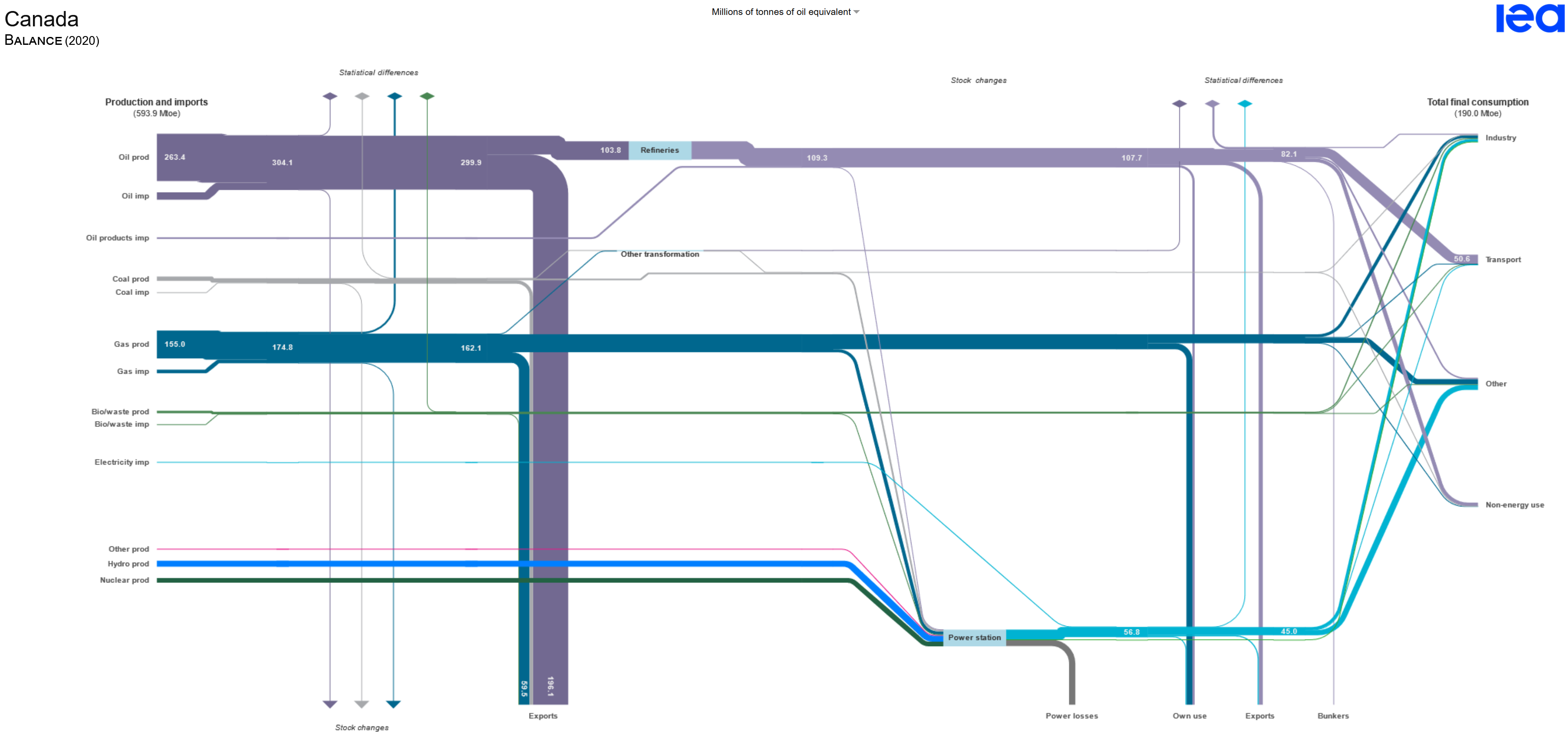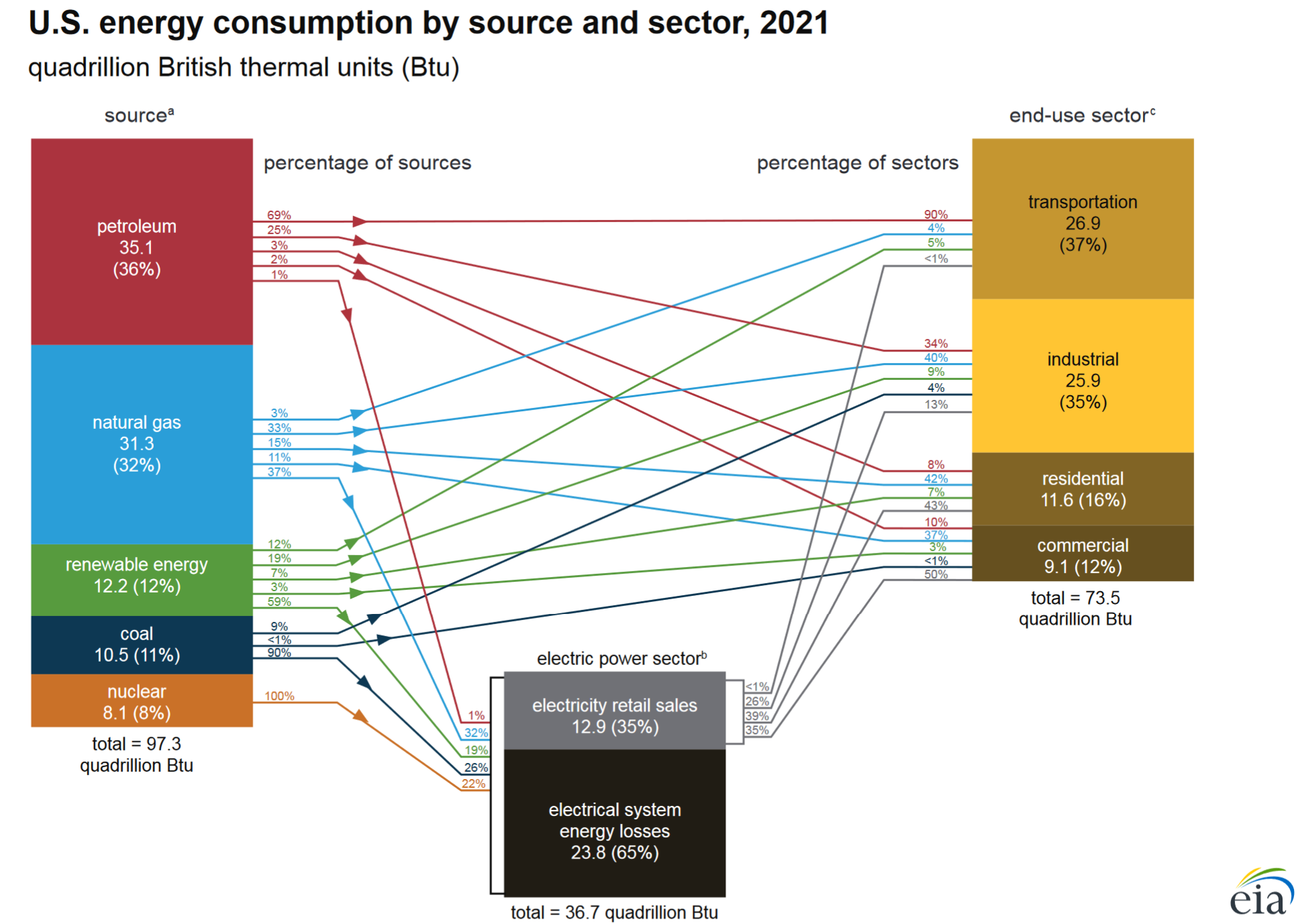ECON 366: Energy Economics
Topic 2.1: Energy Units, Conversion, and Visualization
Andrew Leach, Professor of Economics and Law
Forms of energy
- Potential: Stored energy
- Kinetic: Energy of motion
- Chemical: Energy stored in the bonds of atoms and molecules
- Nuclear: Energy stored in the nucleus of an atom
- Gravitational: Energy stored in an object's height
- Radiant: Electromagnetic energy travels in transverse waves
- Thermal: Vibration and movement of atoms and molecules within substances
- Electrical: Delivered by charged particles called electrons, typically moving through a wire
Energy Classification

Energy Classification Definitions
Primary energy is the energy as it is available as resources: coal, uranium, oil, gas, etc.
Secondary energy is converted into a transportable form, e.g. electricity, gasoline and diesel, or heat.
Final energy is delivered secondary energy: gasoline at the fuel pump, electricity in your home.
Useful energy is the energy that goes towards the desired output as opposed to waste energy. For example, when you run in internal combustion gasoline engine, some energy is lost as heat.
Based on this post from Hannah Ritchie
Energy Classification
- Primary vs. Secondary vs. Final vs. Useful Energy
- See post from Hannah Ritchie mentioned above
- Renewable and Non-Renewable Energy
Renewable energy is energy derived from natural processes that are replenished at a rate that is equal to or faster than the rate at which they are consumed, e.g. energy generated from solar, wind, geothermal, hydropower and ocean resources.
- Clean vs Dirty Energy
- Clean energy is a broader category, e.g. may include nuclear, waste heat capture, etc.
- Commercial and Non-Commercial
- Conventional and Non-Conventional
- Conventional tends to be a moving target
Energy Losses

Calculating Energy Shares
Direct vs. Substitution Methods for calculating shares of primary energy
direct calculations look at the energy supplied via, for example, oil and natural gas, but does not take account of the energy lost in conversion processes.
- substitution method essentially omits the energy wasted in creating that eventual, useful energy that was consumed
Energy Shares

Energy Shares

Calculating Energy Shares
Low-carbon’s share in direct primary energy = % of total primary energy consumption (including all of the inefficiencies of fossil fuel production)
Low carbon’s share in substituted primary energy = % of useful energy (once we subtract all of the wasted energy in the burning of fossil fuels)
Clean vs. Dirty Energy

This will be the first and (I hope) last pie chart we use in this class
Canadian Primary Energy Production

Measurement Classifications
- Volume or mass units: gallons, liters, barrels, cubic meters, tons, tonnes, cords
- Energy value: Calories, Joules, Watts, British thermal unit (BTU), barrel or tonne of oil equivalent (boe or toe)
- Market value: $, €, £, etc.

"Wherever mechanical force is expended, an exact equivalent of heat is always obtained"
- James Prescott Joule, 1843
Richard Feynman on units of energy
Units
- Newton (N) = kg ⋅ ms2
- Joule (J) = 1 N ⋅ m = kgm2s2 = Watt ⋅ Second
- J = Watt ⋅ s.
- What is a Watt?
- Hint: Watt=Work/time
- How many J's do average Albertans use annually?
- 130,000,000,000 J
- Perhaps, we should choose a different unit?
- 130,000,000,000 J = 130 GJ
- What about for all Albertans?
- Scale up to a petajoule, PJ, or 1015 Joules
Units
Where might you run into some of these units?
check you phone/laptop charger (Apple 29W charger, for e.g.)
check your breaker panel at home - you'll see breakers in amps (15A, 20A, 30A, 40A and maybe 100A breakers)
- Household circuits are 120 volts or 240 volts (think pressure of the electricity)
- Amps multiplied by volts equals watts, so a 15A breaker at 120 volts (usual room outlets) have a capacity of 15*120=1,800W.
check your hairdryer (1500W?)
How much energy do appliances use?
| Appliance | Wattage | Hours Per Month | Monthly Consumption (kWh) |
$/Month ($0.1524/kWh) |
|---|---|---|---|---|
| Block Heater | 500 | 120-480 | 240 |
$36.58 |
| Clothes Dryer | 5000 | 6-28 | 140 |
$21.34 |
| Clothes Washer | 500 | 7-40 | 20 |
$3.05 |
| Dishwasher | 1300 | 8-40 | 52 |
$7.92 |
| Hair Dryer | 1000 | 1-10 | 10 |
$1.52 |
| Kettle | 1500 | 1-10 | 10 |
$1.52 |
| Range - Oven | 12,500 | 10-50 | 625 |
$95.25 |
| Refrigerator | 500 | 150-300 | 150 |
$22.86 |
Units
Where might you run into some of these units?
check you phone/laptop charger (Apple 29W charger, for e.g.)
check your breaker panel at home - you'll see breakers in amps (15A, 20A, 30A, 40A and maybe 100A breakers)
- Household circuits are 120 volts or 240 volts (think pressure of the electricity)
- Amps multiplied by volts equals watts, so a 15A breaker at 120 volts (usual room outlets) have a capacity of 15*120=1,800W.
why are you likely to blow a breaker if you run the toaster and the kettle at the same time?
Units in practice


Mechanical energy measurements: kWh
- Typically, electricity is billed per kWh
- What is the relationship between kWh and Joules?
- 1 kW = 1 kJ/s (a flow)
- 1 kWh = 1 kJs × 3600shour = 3600kJ
- How many kWh's do average Albertans use annually?
- Albertan households use 124.6 GJ of energy per year
- 124,600 MJ × 1kWh3.6MJ ≈ 34,600 kWh

Thermal energy: Btus and Calories
- Calorie = energy needed to cool or heat one gram of water by one degree C.
- British thermal unit (Btu): amount of energy needed to cool or heat one pound of water by one degree F.
- Question: What does mBtu mean? mmBtu?
- Various conversions:
- 1 Btu ≈ 252.164401 cal
- 1 Btu ≈ 0.947817 kJ
Common usage - a 24,000 Btu air conditioner means what, exactly?

Sized by how many Btu of heat it can remove in one hour
Commercial measures: toe and tce
- toe (tonne of oil equivalent) is the amount of energy released by burning one tonne (metric ton) of crude oil
- 1 toe ≈ 7.25 barrel of oil equivalent
- 1 toe = 41.87 gigajoules (GJ)
- 1 toe = 39,683,205 Btu (39.7 mmBtu)
- Converting the other way:
- One tonne of gasoline is 1.070 toe
- One tonne of diesel oil is 1.035 toe
- One tonne of Liquefied petroleum gas (propane) is 1.130 toe
- 1 ton of coal equivalent = 1 tce = 29.3076 GJ
You need to know the TPES formula here:








